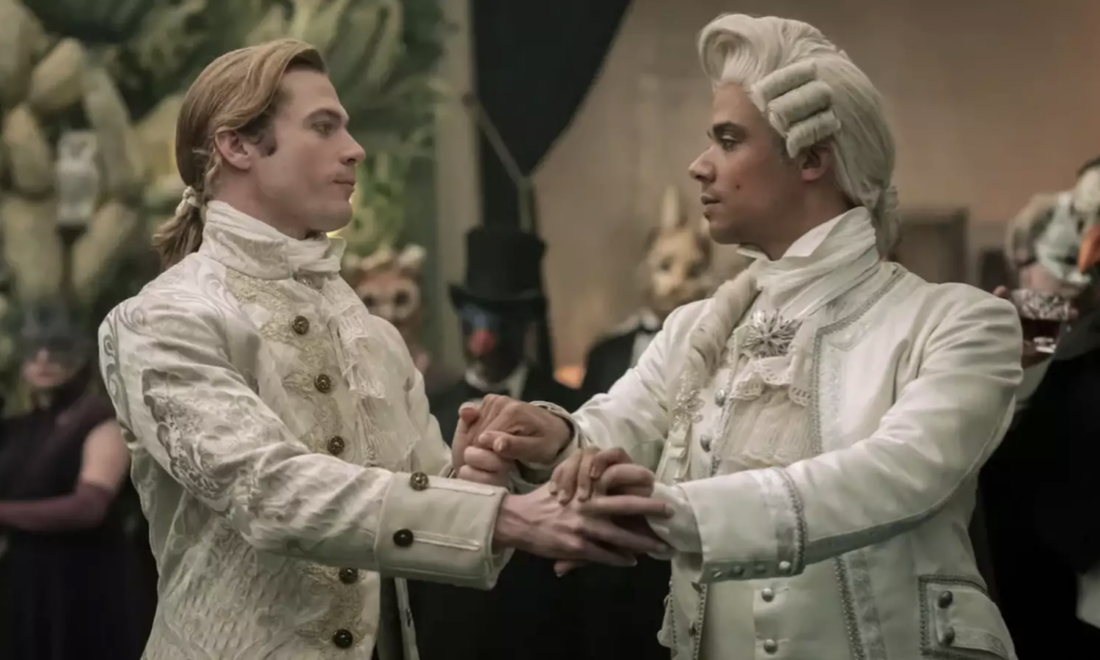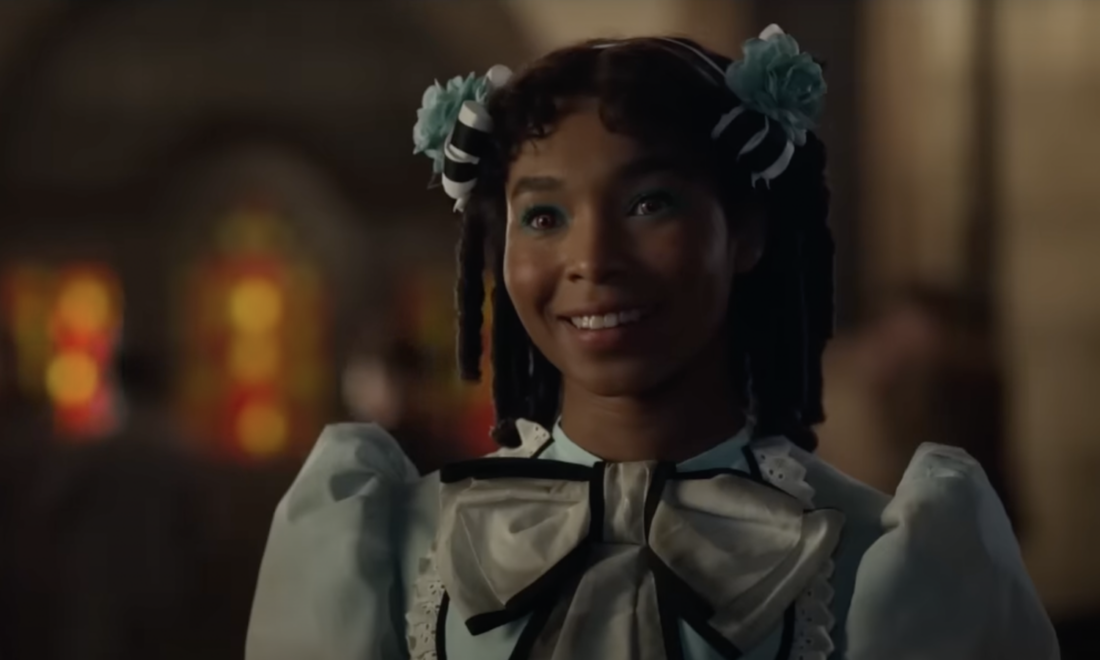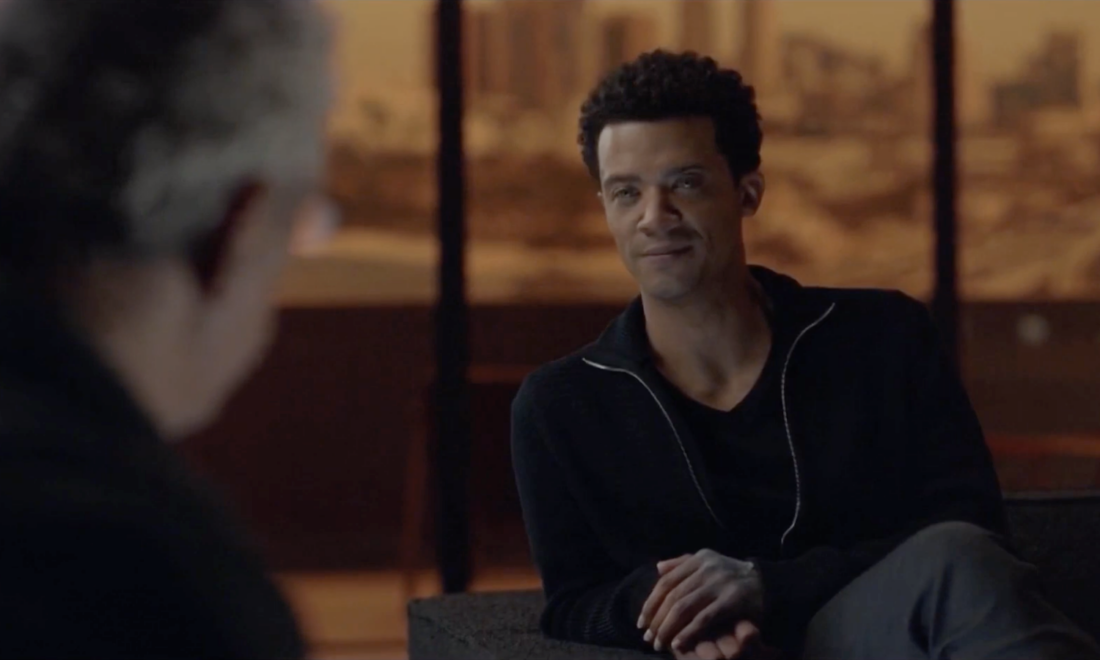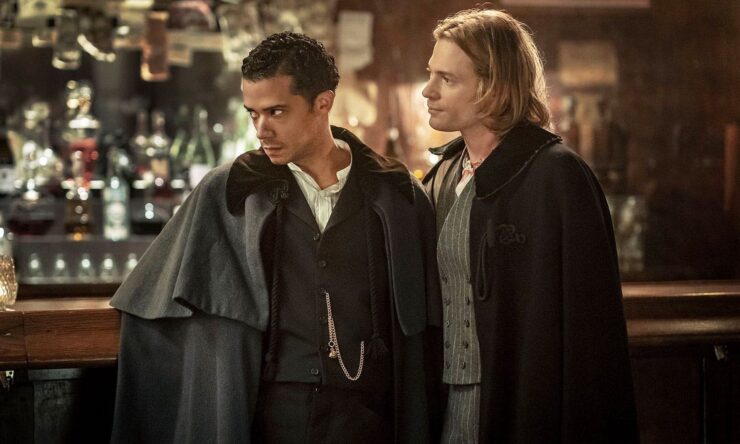The second season of AMC’s absolutely fantastic Interview with the Vampire premieres on May 12th. It’s time we looked back at season one in keen anticipation of the second (and potentially final) season.
Creating a satisfying adaptation of a classic work of fiction is always a thorny and difficult undertaking. It’s even harder when said classic is in need of serious revision in order to be retold. That’s why it’s nothing short of remarkable that AMC’s Interview with the Vampire is so good. The show is based on Anne Rice’s 1976 novel of the same name and probably most familiar to folks in the form of the 1994 Tom Cruise/Brad Pitt film which, if not precisely good, is certainly iconic as a staple of campy, closeted vampire cinema.
The novel, film, and series all split their time between the present day—where journalist Daniel Molloy interviews titular vampire Louis de Pointe du Lac—and various points in Louis’ history, where we learn about his relationship with his abusive, mercurial maker, Lestat de Lioncourt, and their shared ward, the child vampire Claudia. The first season covers, more or less, the first half of the novel, where our vampire protagonists live in New Orleans and try to form a found family before they turn on one another in spectacular fashion.
Revisiting a Problematic Classic

Rice’s original novel is, perhaps, the defining work of the era of the sympathetic vampire—wherein vampires become the protagonists of the novels and films in which they appear and are granted motivations beyond bloodlust and conquest. It’s a turning point for vampires being reassessed as monsters worthy of our sympathy and a clear path to the era of the heroic vampire which includes Twilight, True Blood, and The Vampire Diaries. It’s a masterwork of dark, romantic atmosphere and kinky, sometimes grotesque eroticism (despite containing no sex whatsoever—more on that later).
It’s also, for all of its importance, not a particularly easy book to translate to the screen. For one thing, in the forty-eight years since its publication, Rice’s novel has aged poorly. With the first half of the novel set in New Orleans, there is very little about the city’s Black residents, and what does exist is our vampire protagonist Louis du Pointe du Lac’s assertion that the enslaved African people he owned during his life had more fighting spirit and were free of the servility that later generations of enslaved Americans adopted. It’s a grotesque sentiment and, even if it is offered by an immortal slave owner, Rice doesn’t do anything to push back against it. Compare that to George R.R. Martin’s Fevre Dream, published just six years later—another New Orleans-set vampire novel but one which is explicit and thoughtful (if also imperfect) about the thematic relationship between vampirism and chattel slavery.
Rice’s novel is also difficult to recommend in terms of its relationship to queerness. The romantic tension between Louis and Lestat is an anchoring force in the novel and certainly coded as romantic. But, as mentioned above, for all of the declarations of undying love (in prose that’s occasionally quite purple), there is precious little mention of sex, and Louis and Lestat regard one another with the same passion and affection that they hold for Claudia, who I will remind you, exists in an eternally six-year-old body in the book. All that is to say that Rice’s novel feels erotic, insinuates a kind of eroticism, and, given its protagonists, implies a sprawling queer romance, but never actually defines the nature of its relationships. It ends up being a closeted queer narrative: the sort of thing that might work well in 1976, and provide some plausible deniability for straight heartthrobs in 1994, but feels deeply lacking—even irresponsible—in 2022.
Rather than trying to patch up or ignore the original’s uncomfortable legacy on race and sexuality, the AMC adaptation does an excellent job of centering both, turning what could be the franchise’s biggest liabilities into its strengths. To look at exactly how it does so, we’ll have to examine the central ethos of show’s approach to adaptation…
The Vampire Remix

Bryan Fuller, the showrunner for the absolutely masterful Hannibal, as well as Pushing Daisies, Dead Like Me, Wonderfalls, and the first season of American Gods, was briefly attached to AMC’s Interview with the Vampire series. While it now seems clear that his plan for the series was quite different from what eventually made it to screen, showrunner Rolin Jones’ attitude towards adaptation feels nearly identical to his predecessor’s much lauded vision for Hannibal.
That show was described by Fuller as a “remix” and was often lovingly deemed a sort of “fan fiction” by its most ardent boosters. To my mind, what both labels imply is a sort of adaptation that makes gigantic changes to the plot while staying remarkably consistent when it comes to tone and the overall vibe of the franchise. Hannibal played fast and loose with the events of all four of Thomas Harris’ Hannibal Lecter novels, but remixed extant plot points and characters in such a way that the series felt faithful and familiar without strictly being a re-telling of an already multifariously adapted story.
In Interview with the Vampire this same ethos means that numerous details have been changed but, in nearly all cases, these changes seem to be in the service of making the best parts of Rice’s novel feel relevant and thoughtful. With regard to my earlier comments on the novel’s shortcomings, the departures are the most stark. Louis is Black (played by Game of Thrones’ Jacob Anderson), as is Claudia (played in the first season by Bailey Bass and recast with Delainey Hayles in the second), and their skin color is desperately important to the plot. But it also helps to inform and complicate their original characterizations. Where Rice’s Louis can be passive and retiring to a fault—whiny, even—Anderson’s version of the character is filled with a barely contained rage. His passivity is structurally based in his position as a wealthy Black business owner in New Orleans who must constantly swallow his pride and follow the rules lest he face the wrath of the white supremacist powers that be.
Some of this is also achieved by a shift in the time period. The novel begins its tale in 1791—during the height of New Orleans as a center for the transatlantic slave trade. In moving the start date up to 1911 in the show, it allows Louis some modicum of freedom, elides any need to confront Rice’s specific commentary on slavery, and, arguably, grounds the series in a more vibrant and interesting era of New Orleans history. The Jazz Age and Great Depression lend an air of excess and subsequent melancholy to the proceedings that either reinforce or stand in stark contrast to Louis and Lestat’s troubled romance. The first season’s segments set in the past cover 1910 up through about 1940. This means that the show can play at cleverly matching real-life events to the novel’s plot points. In Rice’s original, Claudia is the orphaned daughter of a plague victim. In the show, she loses her aunt in a fire that is caused by racial violence in 1919, which coincides with the destruction of Storyville where Louis works as a brothel proprietor. Next season seems poised to send Louis and Claudia to Romania in the middle of the second World War and to move its Parisian section from the Belle Epoque of the late 19th century to the mid-1950s.
And that brings us to the explicit queerness of the series. There is no ambiguity about Louis and Lestat’s relationship in AMC’s version. Much like its commentary on race, the show’s commentary on sexuality allows historical bigotry to inform the experience of being a vampire—what does it mean to live forever in a world that never fully acknowledges your personhood, that tolerates you for the supernatural intrigue you connote but still finds you perverse. The first season’s final episode, which sees Louis and Lestat lure immortality-hungry mortals to their deaths as a final goodbye to New Orleans. In recollecting it, Louis tells Molloy that there was more scandal over the two of them openly dancing together than from the murders later that evening, saying “So much would be written about that grim night in New Orleans but not a single mention of our last hour at Latrobe’s. As if the only crime unfit to print took place on that dance floor.” Making Rice’s implications text, ironically, allows a story that has always been about closeted sexuality to be told in more painful, present, and thoughtful terms.
But more than Louis and Lestat’s relationship being merely acknowledged, it’s allowed to be messy and, at times, monstrous. The novel’s Lestat is full of rage and behaves abysmally, but in the hands of actor Sam Reid, he becomes a fascinating comment on relative privilege. Rice’s vampires, living in the shadows, wary of attention, unable to survive without murdering someone every day are often portrayed as pitiable—hunted, haunted. Reid’s Lestat is no exception to this, but the show uses the contrast between himself and Louis to further discuss and explore race. After killing a racist lawyer, much to Lestat’s consternation, Louis declares “There’s some things you don’t get about America.” He draws out the differences between them: “Colored, white. Creole, French. Queer, half-queer, mostly-queer, what is it?” To this, Lestat replied “non-discriminating.” Both in terms of race and sexuality, Lestat is able to pass in the human world and the show uses that passing privilege to drive a wedge between our protagonists. No longer is Louis’ reluctance to drink human blood or his general temerity presented as merely a difference in character (though the show certainly insinuates that Louis is less unhinged and less intrinsically cruel than Lestat) but, in large part, as a response to a world in which he is infinitely more vulnerable.
The final major departure from the books involves the aging up of Claudia. Anne Rice famously lost her five-year-old daughter to leukemia while working on Interview with the Vampire and supposedly had a prophetic dream prior to the diagnosis in which she learned her daughter was dying of something “wrong with her blood.” Claudia, the forever six-year-old vampire of the book has always been theorized to be, in part, the result of that grieving process. She is one of Rice’s most compelling characters—monstrous, tragic, and deeply unsettling. But having a six-year-old who becomes an adult without ever physically aging is a challenge for a screen adaptation. Kirsten Dunst was cast in the ’94 film at age eleven and even that near-doubling of the character’s age still ended up being problematic, with the adult Dunst commenting on the discomfort she felt having to kiss the then-thirty-year-old Pitt on set. Bailey Bass, was nineteen when she played Claudia in the first season and looks young enough to match the character’s age—now fourteen rather than six or eleven.
The age-up absolutely changes Claudia—but in many ways, it changes her for the better. The mix of being trapped in a prepubescent-looking body while being old enough to fully understand the adult world she has been robbed of gives the character a rage that never feels impotent or infantilized. A child’s lack of empathy has been replaced in the show by a teenager’s unhinged chaos and it proves equally scary. Bass played Claudia with a magnetic, discomfiting mixture of piercing wisdom and giggling, teary-eyed malice that will absolutely be missed. It’s a performance that a child actor would struggle to capture and aging her up allows the show to treat her as a co-equal, shouldering much of the series’ dramatic weight. I am excited to see what Delainey Hayles will bring to the character next season, but she has some truly impressive shoes to fill.
The Odyssey of Recollection

This is a show that’s in love with its source material and also careful and thoughtful about updating it. But it has another secret weapon in reflecting on the nature of adaptation: a real dedication to the titular interview. In Rice’s original book (and it’s 1994 adaptation), Daniel Molloy is an aspiring journalist who lucks into an interview with Louis. Both the book and the film treat Molloy’s interview as taking place sometime around each property’s release. The show, rather cannily, posits that there are, in fact, two interviews. The first one takes most of the events of the novel as canon with the interview occurring in San Francisco in 1973 and Molloy being a young reporter (and, in this series, strung out on heroin). But we only see bits and pieces of that interview (the one from the novel), largely towards the end of the season. Most of what comprises the interview portion of the AMC series is an interview set in 2022 with a much older Molloy (played, in the present, by Talk Radio’s Eric Bogosian, looking and sounding more and more uncannily like Anthony Bourdain) now a cantankerous Pulitzer Prize winner who is dying of Parkinson’s and seeking redemption for a life of professional success at the cost of personal fulfillment.
Bogosian’s Molloy is the heart of the series. More than being a framing device, as he was in both book and film, he serves as a meta-textual commentator on the story being told. At numerous points he questions Louis’ story, in part identifying what sounds like overly trope-y genre fiction, calling Louis and Lestat’s relationship “a fucked-up Gothic romance.” At another point, when we see Lestat potentially inspire a young Jelly Roll Morton, Molloy rolls his eyes at Louis for implying that it was a white man who wrote Morton’s famous “Wolverine Blues.”
Beyond being a winking presence, providing a necessary ameliorative to the gorgeous but overwrought narration that Louis uses to tell his tale (occasionally cribbed directly from Rice’s often transcendent prose), Molloy begins to push back on whether or not Louis’ story is true and whether or not it is being told with self-serving embellishments. Louis attempts to reconcile the changes between these two tellings by invoking one of Molloy’s own phrases, “the Odyssey of memory”: the process by which recollection distorts the event. But, as Molloy works his way through primary sources, reading through Claudia’s diaries, a pattern emerges. Parts of the record that conflict with Louis’ telling of events are missing. When Claudia is sexually assaulted, the pages detailing her feelings on the matter have been neatly cut out of the diary. Louis claims it is out of respect for her—to keep private the traumas she recorded in confidence. But Molloy points out that what Louis has actually done is silence her and editorialize on what should and should not be shared.
All of Molloy’s research works to make the audience believe that Louis is not telling the whole truth. And this is not just the Louis of the show. In presenting a second interview that calls into question the first, the show is able to imply that many of its departures from the novel are not retcons so much as they are lies told to the younger and more naive Molloy. This culminates in the reveal at the very end of season that Louis’ valet, Rashid (Assad Zaman) is, in fact, the vampire Armand, a major character from the second half of the novel (played with remarkable gusto by Antonio Banderas in the ’94 film). Nothing is what it should be. Armand has been elided from Louis’ story and has been watching over both interviews in secret, offering his own edit to Louis, unseen by both Molloy and the audience. The tagline for the second season is “Memory is the Monster” and what little has been shown in trailers implies that Molloy is in danger and Louis may be the cause of it.
Interview with the Vampire is one of the rare shows that improves on its already iconic source material. It’s had fifty years to consider how Rice’s novel functions and the impressive legacy it has spawned. It has to contend not only with its own source material but with Twilight, True Blood, Castlevania, and the myriad other zeitgeist-defining vampire tales that owe their existence, in part, to the popularity of Rice’s books.
It does so without altering the spirit of the novel and keeping quite a bit of its lush prose intact. It’s anchored by four absolutely enthralling (perhaps glamoring?) performances that breathe new, complex life into well-established characters. It’s beautifully shot, expertly paced, and incredibly sexy (it makes one question how we ever accepted five years of Jacob Anderson playing a eunuch when this performance was an option). If you haven’t seen it, it’s absolutely worth your while. If you have, well—you have just enough time for a rewatch before the second season premieres next week.










